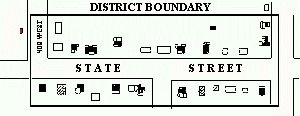
- Home
- History
- Map
- Links
Utah Division of State History National Register of Historic Places Farmington Main Street Historic District Website
- Index
Amasa Lyman and Alice Steed Clark House Annie Clark Tanner House Annie Clark Tanner Rental House Edward Franklin and Aureta Potter Clark House Eugene Henry and Sarah Anne Sessions Clark House Ezra T. Clark Monument Ezra Thompson and Mary Stevenson Clark House Ezra T. and Susan Leggett Clark House Historic Markers Hyrum Don Carlos and Eliza Porter Clark House Isaac and Lovisa Eldora Sears House John Leavitt/Timothy Baldwin and Lucy Rice Clark House Joseph Smith and Lucymaria Robinson Clark House James and Millie G. Millard House Nathan George and Esther Lauretta Ford Clark House Orson Richards and Lucile Barlow Clark House Thomas and Martha Sanders House Van and Barbara Swindle Bass House Verlene Rae Luken Fourplex Verlane Joy and August Jung House- Contact


Clark Lane Historic District - Farmington, Utah The Clark Lane National Historic District is locally significant under criteria A and C of the National Register. It is significant as an example of a family settlement pattern that occurred in Farmington and other communities throughout the State of Utah. The Ezra T. Clark family, which settled in Farmington in 1850 adopted a system of communal ownership which was established and later abandoned by the Church of Jesus Christ of Latter-day Saints. This system continued in the Clark family even after being abandoned by the church. Not until just before the death of Ezra T. Clark in 1901, when many of his children were in their 40's and 50's, did they have a deed to their own homes. This neighborhood is also significant for its concentration of intact homes of a wide variety of architectural influence dating from 1856 to 1970. In the decades after 1940, the Clark Lane Historic District underwent a series of changes largely related to the subdivision of larger family lots to accommodate new housing for the children or other relatives of existing property owners. The increasing density of housing in the district also reflected the impact of the post-World War II boom in marriages and offspring during the years immediately after the war. Six properties in the Clark Lane Historic District were constructed between 1941 and 1970 (i.e., within the extended period of significance. All of the properties are dwellings, the oldest of which was constructed in 1946, and the newest of which was constructed in 1964.
For more information, click here or the History option above.
A Clark Lane painting by Rebecca Mann is available for sale here.
- Index
